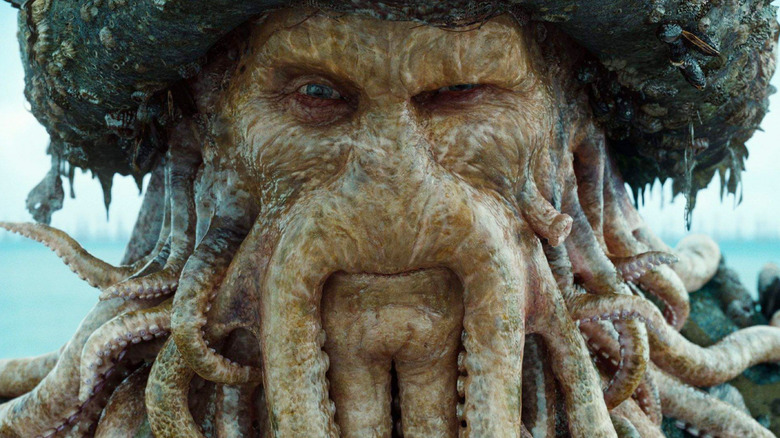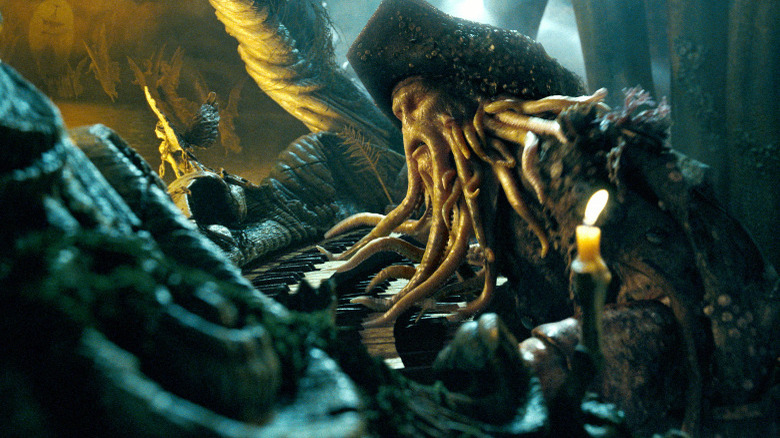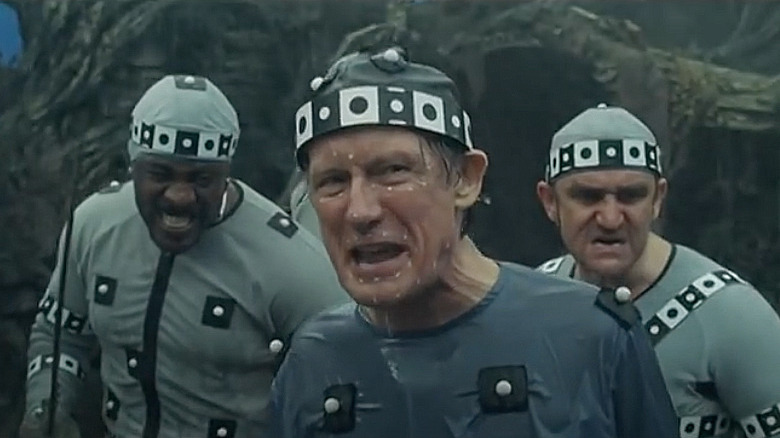How Pirates Of The Caribbean's Crew Brought Bill Nighy's Davy Jones To Life
More than 15 years after he first graced the big screen, Bill Nighy's Davy Jones remains one of the all-time greatest CGI characters brought to life in a live-action movie. I would call this a "hot take," except I feel like most people would absolutely agree with me (so maybe it's more of a "room temperature take").
It's not just the milestone visual effects that continue to impress, either. Nighy's turn as the once-mortal buccaneer in the "Pirates of the Caribbean" films — warped into a twisted cross between an octopus, a human, and a crab by his years of servitude as captain of the Flying Dutchman — is enthrallingly quirky. He makes random popping noises with his lips, cocks his head at strange times, and at one point raises an eyebrow like he's the mischief-making hero in a DreamWorks animated movie. Even as his eyes well up with tears as thick as the slime coating his skin, you find yourself feeling oddly emotional towards this all-too-peculiar sea-man.
On the topic of Davy Jones' eyes — as convincing as they are, they're not actually Nighy's. In a 2006 interview with Entertainment Weekly, visual effects supervisor John Knoll revealed that director Gore Verbinski shot his Davy Jones-centric "Pirates" films, "Dead Man's Chest" and "At World's End," so that, "when we're in tight [on Davy Jones' face], if the CGI doesn't turn out to work well, [we would] be able to use Bill's real eyes." However, thanks partly to Verbinski's practical-heavy approach, Knoll and his team were able to create believable CGI eyes and a whole lot more for Jones using Nighy as a reference only.
The best of both worlds
Gore Verbinski's decision to shoot most of his back-to-back "Pirates of the Caribbean" sequels in real-world locations had multiple benefits when it came to crafting Davy Jones, starting with Bill Nighy's off-beat performance. "On a soundstage with 25 technicians staring at Bill and nobody to play off of, that quirkiness would all have gotten ironed out," said John Knoll. "Somebody would say, 'That gesture is too off or too odd.' It could have become a real sort of committee effort." Instead, so long as Verbinski gave his blessing, Nighy was free to imbue the character with all the personality he could muster, providing Knoll and his effects team with better material to work with.
Shooting in actual parts of the Caribbean and the Bahamas (themselves a beauty to behold all on their own) also meant that Knoll and his fellow artists didn't have to imagine Jones and his crew of half-human, half-sea creature sailors moving through their environments from the ground-up. Instead, the actors playing these characters were filmed performing their scenes on-location in sensor-studded motion-capture suits. This raw footage then gave Knoll and the team a useful point of reference for how everything from the sunlight to ocean water and the sandy beaches ought to interact with the actors' bodies as they ran wild banging swords (er, pardon the phrasing) or being tossed about by the high seas.
The result? Not only better-looking CGI water, sand, and light, but also a smoother blend of the movies' digital and practical elements (making it all the more difficult to tell where one ends and the other begins).
Being Davy Jones
Nowadays, a growing number of actors have gone through what you might call the rite of passage that is wearing a ridiculous motion-capture suit in order to portray a computer-animated character in a live-action film. Back in the early aughts, however, this was still a fairly novel experience for anyone not named Andy Serkis. That being the case, John Knoll admitted Bill Nighy wasn't exactly enthused about having to wear what he dubbed "pirate pajamas" to bring Davy Jones to life, not least of all when most of his co-stars got to shoot the "Pirates of the Caribbean" sequels decked out in costume designer Penny Rose's ornate swash-buckling outfits.
As silly as Nighy surely felt in his "bizarre Devo jumpsuit" (as Knoll also called it) with dots on his face, his gear was essential in aiding the films' visual effects artists in tracking his body movements and facial mannerisms for the CGI Davy Jones during post-production. Another benefit: Using Industrial Light & Magic's mo-cap system freed Gore Verbinski to employ a lot more hand-held camera-work than he would've been able to otherwise, making the scenes with Jones feel all the more natural and not pre-planned. That is, after an animated team led by Hal T. Hickel spent months of labor-intensive work turning Nighty's on-set antics into what you see in the finished product.
Knoll, Hickel, and their fellow VFX supervisors Charles Gibson and Allen Hall would go on to take home the Academy Award for Best Achievement in Visual Effects thanks to "Pirates of the Caribbean: Dead Man's Chest," and it was a victory well-deserved. But if these details prove anything, it's that terrific CGI creations like Davy Jones are a true group effort. Trying to do everything in post is hardly conducive to the process.


